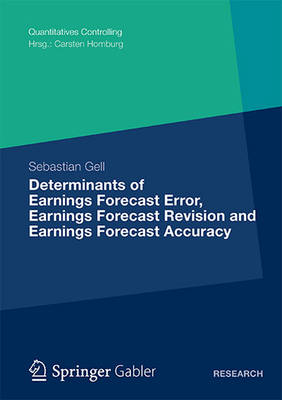
Door een staking bij bpost kan je online bestelling op dit moment iets langer onderweg zijn dan voorzien. Dringend iets nodig? Onze winkels ontvangen jou met open armen!
- Afhalen na 1 uur in een winkel met voorraad
- Gratis thuislevering in België vanaf € 30
- Ruim aanbod met 7 miljoen producten
Door een staking bij bpost kan je online bestelling op dit moment iets langer onderweg zijn dan voorzien. Dringend iets nodig? Onze winkels ontvangen jou met open armen!
- Afhalen na 1 uur in een winkel met voorraad
- Gratis thuislevering in België vanaf € 30
- Ruim aanbod met 7 miljoen producten
Zoeken
Determinants of Earnings Forecast Error, Earnings Forecast Revision and Earnings Forecast Accuracy
Sebastian Gell
€ 52,95
+ 105 punten
Omschrijving
Earnings forecasts are ubiquitous in today's financial markets. They are essential indicators of future firm performance and a starting point for firm valuation. Extremely inaccurate and overoptimistic forecasts during the most recent financial crisis have raised serious doubts regarding the reliability of such forecasts. This thesis therefore investigates new determinants of forecast errors and accuracy. In addition, new determinants of forecast revisions are examined. More specifically, the thesis answers the following questions: 1) How do analyst incentives lead to forecast errors? 2) How do changes in analyst incentives lead to forecast revisions?, and 3) What factors drive differences in forecast accuracy?
Specificaties
Betrokkenen
- Auteur(s):
- Uitgeverij:
Inhoud
- Aantal bladzijden:
- 125
- Taal:
- Engels
- Reeks:
- Reeksnummer:
- nr. 1
Eigenschappen
- Productcode (EAN):
- 9783834939364
- Verschijningsdatum:
- 3/04/2012
- Uitvoering:
- Paperback
- Formaat:
- Trade paperback (VS)
- Afmetingen:
- 150 mm x 210 mm
- Gewicht:
- 204 g

Alleen bij Standaard Boekhandel
+ 105 punten op je klantenkaart van Standaard Boekhandel
Beoordelingen
We publiceren alleen reviews die voldoen aan de voorwaarden voor reviews. Bekijk onze voorwaarden voor reviews.











